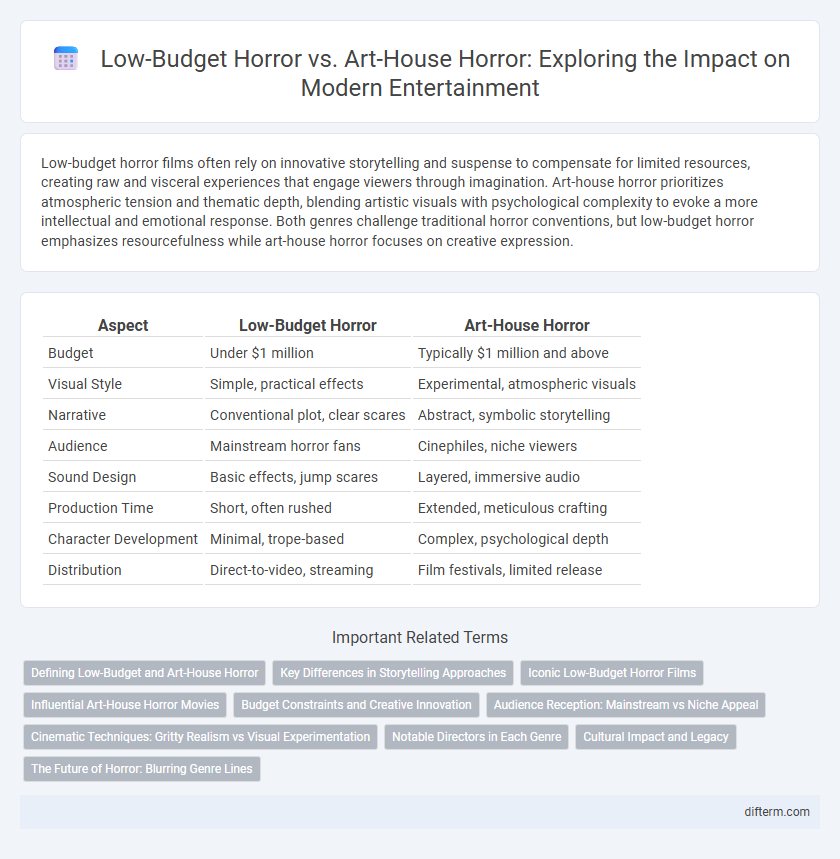Low-budget horror films often rely on innovative storytelling and suspense to compensate for limited resources, creating raw and visceral experiences that engage viewers through imagination. Art-house horror prioritizes atmospheric tension and thematic depth, blending artistic visuals with psychological complexity to evoke a more intellectual and emotional response. Both genres challenge traditional horror conventions, but low-budget horror emphasizes resourcefulness while art-house horror focuses on creative expression.
Table of Comparison
| Aspect | Low-Budget Horror | Art-House Horror |
|---|---|---|
| Budget | Under $1 million | Typically $1 million and above |
| Visual Style | Simple, practical effects | Experimental, atmospheric visuals |
| Narrative | Conventional plot, clear scares | Abstract, symbolic storytelling |
| Audience | Mainstream horror fans | Cinephiles, niche viewers |
| Sound Design | Basic effects, jump scares | Layered, immersive audio |
| Production Time | Short, often rushed | Extended, meticulous crafting |
| Character Development | Minimal, trope-based | Complex, psychological depth |
| Distribution | Direct-to-video, streaming | Film festivals, limited release |
Defining Low-Budget and Art-House Horror
Low-budget horror films typically utilize limited financial resources to create suspense and fear through practical effects, minimalistic settings, and innovative storytelling techniques, often relying on atmospheric tension rather than high-cost visuals. Art-house horror, characterized by experimental narratives, symbolic imagery, and thematic depth, merges aesthetic sophistication with horror elements to evoke psychological unease and provoke intellectual engagement. Both genres challenge traditional horror conventions but differ in their production scale and artistic intent.
Key Differences in Storytelling Approaches
Low-budget horror relies on straightforward narratives and practical effects to evoke fear through raw, often visceral experiences, emphasizing suspense and jump scares over complex themes. Art-house horror prioritizes atmospheric tension, symbolism, and psychological depth, often exploring existential or metaphysical questions with abstract storytelling and experimental visuals. The key difference lies in low-budget horror's focus on immediate emotional impact, whereas art-house horror seeks to provoke thought and interpretative engagement.
Iconic Low-Budget Horror Films
Iconic low-budget horror films like "The Blair Witch Project" and "Paranormal Activity" demonstrate how minimalist production and innovative storytelling can generate immense suspense and widespread cultural impact despite limited resources. These movies rely on atmospheric tension, found-footage techniques, and strong audience imagination rather than high-end special effects common in art-house horror. Their success highlights the power of creativity and grassroots marketing in establishing enduring horror classics with modest budgets.
Influential Art-House Horror Movies
Influential art-house horror movies like "Suspiria" (1977), directed by Dario Argento, and David Lynch's "Eraserhead" (1977) have redefined the genre by emphasizing atmospheric tension and surreal visuals over traditional scares. These films prioritize psychological depth, symbolic imagery, and experimental sound design, distinguishing themselves from low-budget horror's reliance on jump scares and gore. Their impact is evident in contemporary horror cinema, inspiring directors to blend avant-garde aesthetics with narrative complexity.
Budget Constraints and Creative Innovation
Low-budget horror films leverage budget constraints to drive creative innovation, often resulting in unique storytelling and atmospheric tension that compensates for limited special effects. Art-house horror prioritizes avant-garde aesthetics and thematic depth, using minimal resources to explore psychological and surreal elements over conventional scares. Both subgenres transform financial limitations into opportunities for originality and artistic expression within the horror genre.
Audience Reception: Mainstream vs Niche Appeal
Low-budget horror films often attract mainstream audiences with their accessible scares and familiar tropes, creating widespread appeal through high-impact, cost-effective storytelling. Art-house horror targets niche audiences by emphasizing psychological depth, avant-garde aesthetics, and experimental narratives, which resonate strongly with viewers seeking intellectual and artistic engagement. Both subgenres utilize distinct stylistic approaches that shape audience reception, with low-budget horror thriving on immediacy and spectacle, while art-house horror cultivates a cult following through thematic complexity and atmospheric tension.
Cinematic Techniques: Gritty Realism vs Visual Experimentation
Low-budget horror films often rely on gritty realism through handheld camerawork, natural lighting, and raw sound design to create an immersive and visceral experience. Art-house horror emphasizes visual experimentation using unconventional camera angles, surreal imagery, and innovative editing techniques that challenge traditional narrative structures. These contrasting cinematic techniques define the distinct atmospheres and emotional impacts of each horror subgenre.
Notable Directors in Each Genre
Low-budget horror often features directors like James Wan, whose work on "Saw" revolutionized the genre with minimal budgets and inventive storytelling. In contrast, art-house horror showcases auteurs such as Ari Aster, whose films like "Hereditary" combine psychological depth and stylistic innovation. Both genres rely on distinct directorial approaches that shape their unique cinematic experiences and audience appeal.
Cultural Impact and Legacy
Low-budget horror films often achieve cult status through raw creativity and grassroots appeal, influencing mainstream horror by pushing genre boundaries with minimal resources. Art-house horror, recognized for its stylistic innovation and philosophical themes, leaves a lasting cultural impact by challenging conventional narratives and appealing to niche audiences interested in cinematic artistry. Both subgenres contribute uniquely to horror's legacy, shaping audience expectations and inspiring future filmmakers worldwide.
The Future of Horror: Blurring Genre Lines
Low-budget horror films leverage innovative storytelling and practical effects to create intense atmospheres on limited budgets, pushing creative boundaries. Art-house horror combines stylistic visuals and deep thematic exploration, appealing to niche audiences and elevating the genre's artistic credibility. The future of horror lies in blending these approaches, where resourceful filmmaking meets avant-garde aesthetics, resulting in genre-defying works that captivate diverse viewers.
Low-budget horror vs Art-house horror Infographic

 difterm.com
difterm.com